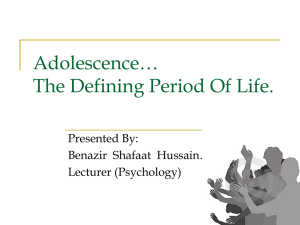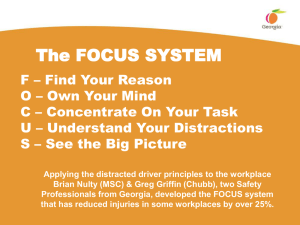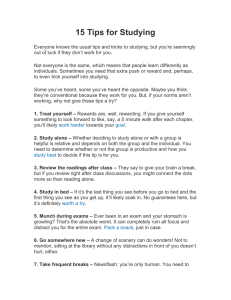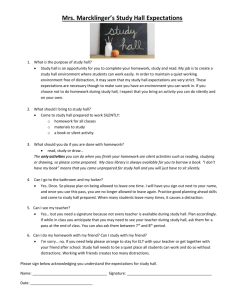Ignoring Distractions - Milwaukee Public Schools
advertisement
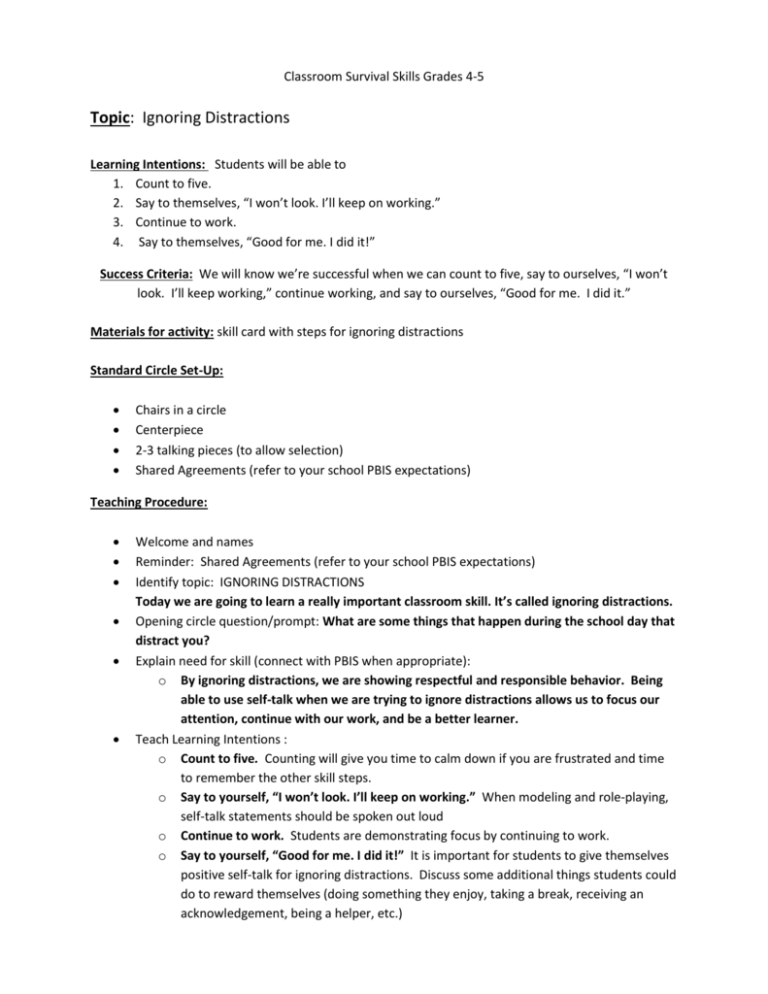
Classroom Survival Skills Grades 4-5 Topic: Ignoring Distractions Learning Intentions: Students will be able to 1. Count to five. 2. Say to themselves, “I won’t look. I’ll keep on working.” 3. Continue to work. 4. Say to themselves, “Good for me. I did it!” Success Criteria: We will know we’re successful when we can count to five, say to ourselves, “I won’t look. I’ll keep working,” continue working, and say to ourselves, “Good for me. I did it.” Materials for activity: skill card with steps for ignoring distractions Standard Circle Set-Up: Chairs in a circle Centerpiece 2-3 talking pieces (to allow selection) Shared Agreements (refer to your school PBIS expectations) Teaching Procedure: Welcome and names Reminder: Shared Agreements (refer to your school PBIS expectations) Identify topic: IGNORING DISTRACTIONS Today we are going to learn a really important classroom skill. It’s called ignoring distractions. Opening circle question/prompt: What are some things that happen during the school day that distract you? Explain need for skill (connect with PBIS when appropriate): o By ignoring distractions, we are showing respectful and responsible behavior. Being able to use self-talk when we are trying to ignore distractions allows us to focus our attention, continue with our work, and be a better learner. Teach Learning Intentions : o Count to five. Counting will give you time to calm down if you are frustrated and time to remember the other skill steps. o Say to yourself, “I won’t look. I’ll keep on working.” When modeling and role-playing, self-talk statements should be spoken out loud o Continue to work. Students are demonstrating focus by continuing to work. o Say to yourself, “Good for me. I did it!” It is important for students to give themselves positive self-talk for ignoring distractions. Discuss some additional things students could do to reward themselves (doing something they enjoy, taking a break, receiving an acknowledgement, being a helper, etc.) o Success Criteria: We know we are successful when we can count to five, say to ourselves, “I won’t look. I’ll keep working,” continue working, and say to ourselves, “Good for me. I did it.” A. Model examples and non examples of ignoring distractions. a. Get up, move to the window, walk around the room, and water their plants as a student is reading a story to the group. b. Ask the students: What did you notice about what you were doing while _________was reading the story? Elicit responses by having students raise hands to discuss their actions. Say, Now that you know the steps of ignoring distractions, could any of you have done something different? c. Have the student who was reading choose a volunteer who wants to continue reading out loud. When the student begins reading, pretend to be a student sitting at a desk working on another assignment. You could get distracted, stop working, and listen to the reading, but instead, model the steps for ignoring distractions by doing the following aloud: Count to five, say to yourself, “I won’t look, I’ll keep working,” continue working and then say to self, “Good for me, I did it.” B. Provide students with examples and non examples of ignoring distractions. After each example, ask students: What steps for ignoring distractions were used in each example? Which steps were missed? a. You are supposed to be working with a group and completing a social studies review. Two people in your group are talking about what they did last night. You stop working and talk with them. b. Students are entering the room late because there was a bad snowstorm and the busses are arriving at many different times. You count to five, you don’t look up, and you continue working on your opening activity. c. Your classroom faces the playground and some kids are outside on a nice day playing kickball. You put down your pencil and gaze out the window. C. Practice/Role Play 3X: Have each student describe a situation in which they could use this skill. Role play these situations or choose any of the following scenarios to role play. (For a detailed model of how to use role play and give feedback, see Skillstreaming.) a. You are taking a test in class. Two people in front of you keep whispering back and forth and it is starting to bother you. Role play what you might do. b. Your class has a pet hamster. During quiet reading time, the hamster decides to climb into the squeaky wheel and exercise. The noise is beginning to bother you. Role play what you might do. c. A classmate is throwing paper into the waste basket over your head while you are completing your vocabulary work. Role play what you might do. Activity to practice skill: Snap, Crackle, Pop (Ropes & Challenges Education Curriculum Guide) Participants stand in a circle and all face in, towards the center. The leader selects one member to begin after demonstration. Participants say: “SNAP” and make the appropriate arm motion either left or right (Snap: hold right arm over head pointing left or hold left harm over head pointing right). The person who is pointed to must say: “CRACKLE” and make the appropriate arm motion either left or right (crackle: hold right arm chest high pointing left or hold left arm chest high pointing right). The participant who was pointed to must say: “POP” and make the appropriate arm motion towards someone across the circle from them (Pop: clap both hands together, palms touching, fingers pointed away from your body and pointing to a particular person). Participants may snap or crackle to their immediate left or right. The participant can Pop anywhere else in the circle, but not to their immediate left or right (except when there are less than five people in the circle). A player is “out” if they say the wrong word or do the wrong action, or don’t do anything when it’s their turn. The group then put their thumbs in the circle and says: “you’re out of here” (as an umpire would throw a player out of a baseball game). The players who are now “out” must walk about the circle and call out to the active players, trying to distract them. No touching is allowed. After playing a few rounds relate the game to the idea of ignoring distractions. Discuss the idea that the students had to stay very focused and use ignoring skills when someone was deliberately trying to get their attention. Discuss whether this happens in class and how/when students could use their new skills. Closing Circle Question: How will you practice ignoring distractions this week?

